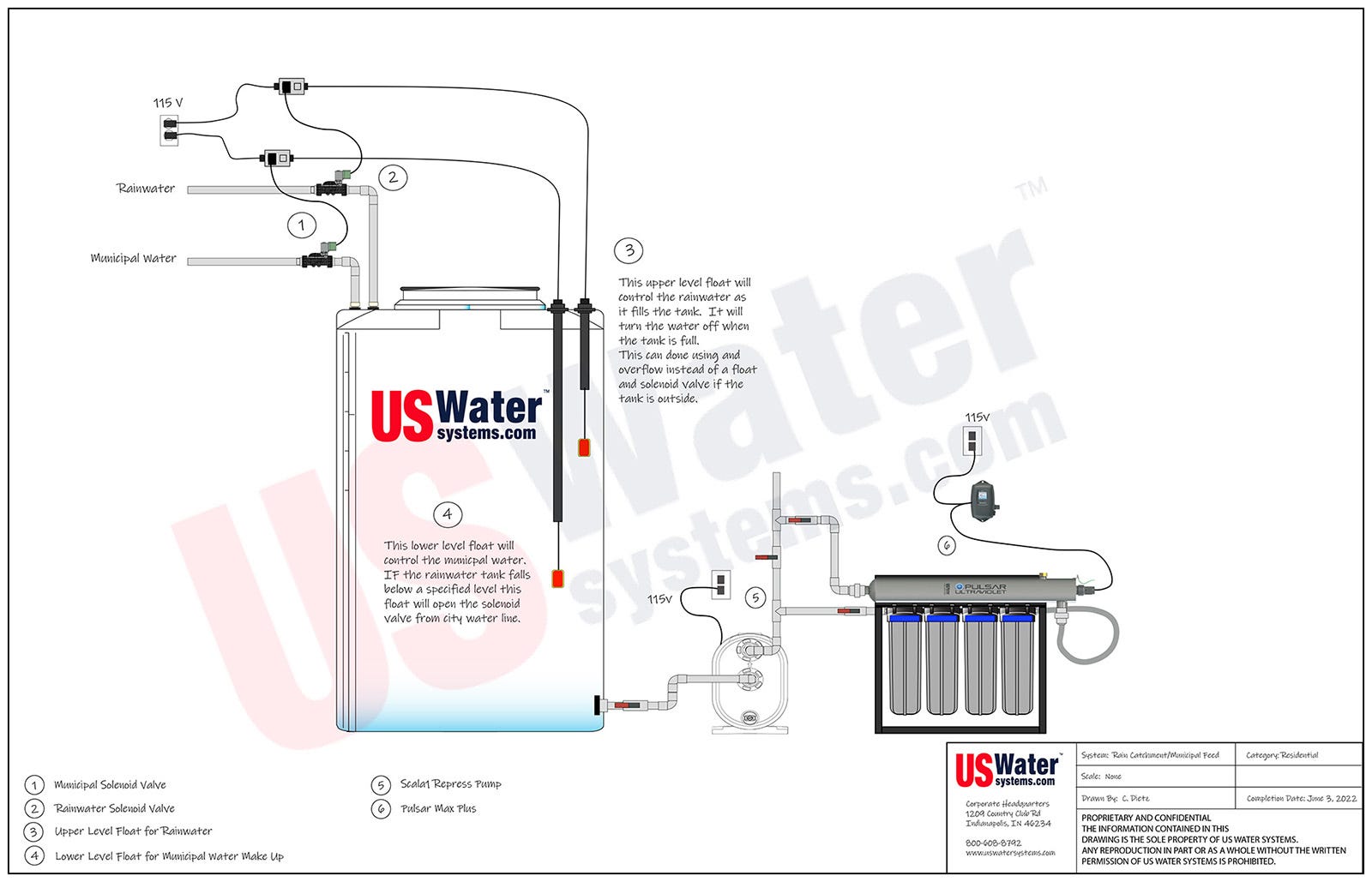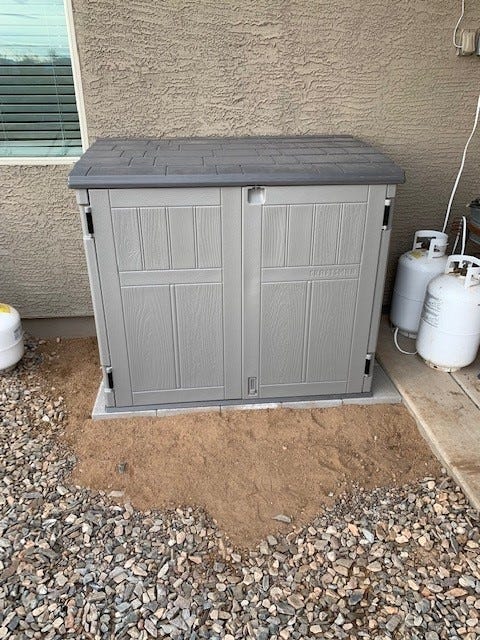Rainwater Harvesting When There Is No Other Choice
“Rainwater harvesting” is simply the collecting and using rainwater as a way to conserve resources. Some people use rainwater for watering plants, cleaning, bathing, and even drinking. Like any water treatment process, it is vitally important that a rainwater harvesting system be properly engineered and that it be maintained efficiently so as to not compromise water quality.
Should you want to engage in rainwater harvesting, you should investigate your local and state laws regarding it. Any amount of rainwater that you harvest won't be able to enter nearby streams, ponds, and other natural bodies of water. That does have the potential to disrupt natural ecosystems. The amount of rainwater which you can collect varies - Colorado allows only a total of 110 gallons, while Illinois allows residents to harvest up to 5,000 gallons without a permit. Be sure you do not run afoul of your local ordinances.
Some people have 55-gallon rain barrels located at several downspouts. These are generally used for watering flowers, plants and gardens. Others may have 5,000-to-10,000-gallon (or even larger) tanks (often called cisterns) which can be buried in the ground. This type of rainwater harvesting is generally utilized for whole house rainwater usage.
In most states, except for Colorado, rain barrels are not regulated, but cisterns may require a professional engineer or plumber to design the system to ensure the water is properly harvested and filtered for use. Be sure and do your due diligence before digging. There may be several permits involved. Be sure and check with your State's Health Department, Department of Agriculture, or Water Board for any rainwater harvesting regulations. Rainwater collection is not regulated by Federal Law, so you will always be checking with your State and Local Authorities.
I am not going to even attempt to list regulations for every State as Climate Change, growing demand for water and new regulations will forever be changing. This is not an “up-to-date” repository of rainwater harvesting regulations. They will vary from State-to-State and even within those different jurisdictions. There is an old saying that goes like this: “Measure twice - Cut once!” Be sure that you understand that because is certainly applies in this circumstance.
Have you ever noticed how clean the air smells after a rain? The rainwater actually is washing and cleaning the air of contaminants. While rain is actually removing contaminants from the air it can create another problem for the rainwater user: The rain also washes different types of contaminants into the water you collect (for example, bird poop on your roof could end up in your water barrel or tank). Rainwater can also carry bacteria, parasites, viruses, and chemicals that could make you sick, and rainwater has been linked to various waterborne disease outbreaks around the world.
The risk of anyone getting sick from rainwater will vary dramatically, depending upon your location and what you are using rainwater for. Consideration will have to be given as to how frequently it rains, the differences in seasons, and how you collect and store the rainwater. Dust, smoke, carbon dioxide, and particles from the air can contaminate rainwater before it lands on your roof. Roofing materials, gutters, piping, and storage materials can introduce harmful substances such as copper, asbestos, and lead, into the water. Dirt and germs can be washed into collected rainwater from the roof, especially when rain follows several days of dry weather.
To lower your risk of getting sick, consider using rainwater only for uses such as watering plants that you don't eat or washing items that are not used for cooking or eating. Avoid using rainwater for drinking, cooking, brushing your teeth, or rinsing or watering plants that you intend to eat. Unfortunately, this is not a perfect world and sometimes rainwater harvesting may be the only choice for a water supply.
NOT TO WORRY! We have the technology to treat rainwater so that it is perfectly safe to drink and free of bird poop, chemicals, bacteria, lead, copper, protozoa and cysts, but such a systems should be engineered by a professional familiar with all of the issues of rainwater harvesting.
Certain people can tolerate contaminants in the water better than others. Infants, the elderly, the immune compromised and individuals with autism frequently are the ones who have difficulty with this as their stomachs do not produce as much acid as other individuals. A rainwater harvesting systems should be designed with even the immune compromised in mind. Trying just to “get by” or being just “good enough” is not good enough. If you are going to utilize a Rainwater Harvesting System, it needs to be engineered to be as comprehensive as possible.
EVERY CASE IS DIFFERENT
- Water quality varies.
- Roof materials vary.
- Bird poop varies (really).
- In some areas, you have to deal with bat poop.
- Vents, drains and other connecting pipes need to have screens to prevent bugs, spiders, snakes, frogs and other organisms from entering the system.
- In some cases, algae my proliferate and continual chlorination (with a chemical injection pump) might be necessary.

- In other cases, chlorine may not be necessary and in some cases, throwing a few chlorine pellets into a tank periodically may be the solution. A WELL SAFE CHLORINE SHOCK KIT works perfectly for this.

- If you do have to occasionally chlorinate or continually chlorinate, then be sure that you are able to properly remove the chlorine and the resultant Disinfection By-Products (DBP's) from the water supply. These DBP's can be carcinogenic and need to be removed with sufficient amounts of carbon with plenty of contact time for full absorption. This is typically accomplished with a “tank-type” carbon filter, whether it be backwashing or non-backwashing.
- We have been extremely successful with our US Water Systems Pulsar MAX PLUS Ultraviolet Disinfection System

It offers five-stages of protection for your Rainwater Harvesting System and is equipped to inactivate chlorine-resistant parasites such as Cryptosporidium and Giardia, harmful bacteria like E.Coli and viruses not visible to the naked eye.
PULSAR MAX PLUS SYSTEM with 5-Stages of Protection
- Stage 1: 5 Micron Magna Pre-Filter The first stage traps all particles above 5 microns, which is typically 70-80% of the solids, silt, sand and sediment.
- Stage 2: Radial Flow Carbon Filter - The second stage consists of a coconut shell granular activated carbon which removes, chemical, taste, odors and chlorine.
- Stage 3: 1 Micron Magna Pre-Filter Next, the second stage steps-down to 1 micron which is the size of Giardia and Cryptosporidium Cysts. At this juncture, nearly 100% of the solids have been removed.
- Stage 4: Interceptor Sub-Micron Filter Now, its time to go through the Disrupter media with a Zeta potential of 51 millivolts. Many contaminants are actually "magnetically" removed from the water supply and "secured" in the Charged Filter. It stops things like bacteria, lead, tannin and Chromium 6.
- Stage 5: Pulsar Ultraviolet Disinfection Chamber The Pulsar UV is the most advanced ultraviolet system on the market today. It assures 100% destruction of bacteria, parasites, virus and cysts when preceded by the Interceptor cartridge. Solid-state computerized system tells you exactly when to perform maintenance.
Like most US Water Systems products, the Pulsar Max Plus is Made in America. That includes the filter housings, the filter cartridges and the frame - all 100% American Craftsmanship. The Ultraviolet System is Made in Canada (which is where just about every UV is made). This is high quality system that requires filter changes typically once or twice a year along with yearly UV Bulb replacement.
The Pulsar Max Plus Ultraviolet Disinfection System addresses the Bacterial Purity and Taste of your water like no other system to provide a FAIL-SAFE protective cocoon around you and your family's water giving you the ultimate water quality and peace of mind. With the Pulsar Ultraviolet MAX Plus System you can enjoy bacteria-free clear, clean great-tasting water with chemicals, tastes and odors removed from every tap in your home.
Below is a typical diagram of a rainwater installation system on city water note the dual feed options (upper LH corner). It can run on city water or rainwater. Please consult your local plumbing code so that you do not have any illegal connections and/or use proper backflow prevention.

Here is what one customer used for their US Water Systems Rainwater Harvesting System:








5 Comments
I watch a show called “Homestead Rescue”. There are many “Off-Grid” homes that use rain water catchment systems, but most do not have a purifying system. Most of the rain water is used for their crops and animals, but some have had serious contamination that made the dwellers sick. Unfortunately, most of those on said show are under financed, and down to their last dollar; hence, a “Rescue” was needed. Maybe a program could be put together where “We” the buyers could donate one dollar to help some people in need. Personally, I wouldn’t mind giving 1$ to help others, for it is a small price that most of us can easily afford.
Unfortunately, in my Southern Nevada home rain catchment is prohibited. I can install a gutter system and run the water away from the house, but it must end up on the ground.
I would like a sample of the purifier for my domestic use. Please send me the price up to Nairobi Kenya. For my health drinking.
I will have a CSR reach out to you.
I learned lots about chlorination when we had our systems treated at work.
I will not hesitate to use rainwater if I have to but chlorine definitely helps with everybody’s safety!!
You can use chlorine, but I would not do it on a regular basis, because chlorine can create trihalomethanes which are known carcinogens. UV does nothing of the sort, and I would trust it over chlorine, but hey, what do I know? I’m only a Master Water Specialist with 50 years of experience!
Leave a comment
Please note, comments need to be approved before they are published.